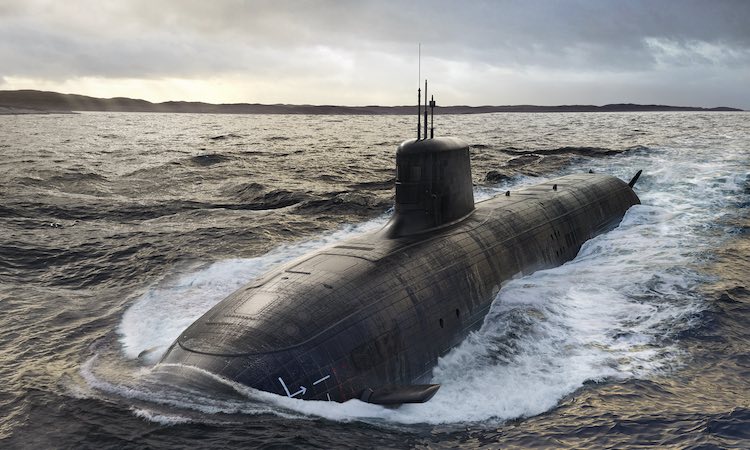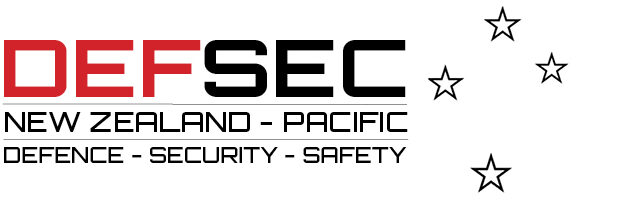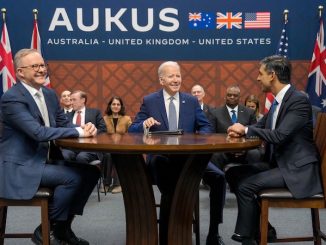

The AUKUS arrangement poses big questions for New Zealand’s approach to alliances and naval capability. Wayne Mapp writes that the response will need leadership from the top.
The most important security issue currently facing New Zealand is working out our role with AUKUS. New Zealand’s most important security partners, Australia, the United States and the United Kingdom have hugely upgraded their mutual security through the AUKUS partnership.
With the procurement of up to eight nuclear powered submarines through the AUKUS partnership, Australia will have one of the most formidable navies in the world.
Although there is no prospect of New Zealand being involved in any aspect of AUKUS that involves nuclear technology, AUKUS provides other opportunities for engagement. Pillar Two of AUKUS involves emerging technologies, including artificial intelligence, hypersonics, and quantum computing. Two of these are also directly relevant to the intelligence activities of Five Eyes. Quantum computing will allow GPS level accuracy without needing a satellite signal
There is of course a prior question: to what extent does New Zealand want to upgrade its relationship with the AUKUS partners? This question could be put another way: is New Zealand prepared to accept a progressive downgrading of its relationships with the AUKUS nations – because that is surely what will happen if New Zealand does not participate in Pillar Two of AUKUS.
The Far-Left parties in Parliament have no doubt about their answer to these questions. The Green Party and Te Pati Maori want New Zealand to withdraw from all security relationships, and in particular, from Five Eyes. This stance extends to AUKUS.
Read it in the digital edition of Line of Defence Magazine…
The positions of these parties is well known, and in the case of the Green Party extends back many decades. However, these two parties also represent less than 20 percent of New Zealand voters, which has also been the case for decades. In short, there is a substantial majority in Parliament, and among New Zealand voters, that our current security relationships should be maintained, and be kept in good order.
The majority position was well stated by Minister of Defence, Andrew Little, when he said in May this year that New Zealand had already picked a side decades ago. Although this statement was made with specific reference to New Zealand’s active support for Ukraine and the rule of law, no-one could mistake the broader meaning. On matters of security, New Zealand knows who its partners are.
Security relationships require a certain level of commitment, if they are to be taken seriously. Not slavishly, as New Zealand’s stand on Iraq showed, but at a sufficient level to be seen to be making a useful contribution.
Even in a proportionate sense, New Zealand’s contribution does not match that of the AUKUS partners, and this has been the case for many decades. Nevertheless, the contribution to security partnerships has to be more than token, it must add something of real value.
I have seen the treatment of a nation who was seen as only making a token, almost derisory effort. That was Greece in the Afghanistan mission. Greece paid a deep political and economic price for offering only 12 people to the Afghanistan mission. Only now, nearly two decades later, is Greece being accorded a more respectful position within NATO.
AUKUS is not just about technology transfer. Much more importantly, it is about reinforcing fundamental security relationships. The three partner nations have held together for over a century. This is also true of the two other Five Eyes nations, Canada and New Zealand.
The five nations, with their global trading links, have had a traditional focus on maritime power, these days, both encompassing both naval and air. At various times in the past, the greatest proportion of the five nations respective military strength has been primarily vested in naval and air power.
The pinnacle of the AUKUS partnership is the investment in nuclear powered submarines. This is truly an awesome level of commitment for a state with the economy and population of Australia.
It is not just two, three or four nuclear submarines, it is eight. To put this into perspective, the eight nuclear attack submarines will be more than the seven Astute class submarines in the Royal Navy and more than the six Barracuda nuclear attack submarines that the French Navy has ordered.


Australia is truly committed to building one of the most formidable navies in the world, surpassed only by those of the long-established nuclear powers.
The Australian naval build up is not just in the nuclear submarines, it is also reflected in the Australian Navy’s surface fleet. Australia already has three advanced air warfare destroyers. It is now replacing the eight ANZAC frigates with nine substantially larger Hunter class frigates.
At nearly 10,000 tonnes displacement, the Hunter class ships blur the traditional distinction between destroyers and frigates. Following the publication of the Defence Strategic Review earlier this year, a specific review of the surface combatant fleet was required, with a report back in September this year. Although the Hunter class project will be part of this review, a large amount of work has already been done on those ships.
There could be a reduction in numbers of the Hunter class made up by the possible acquisition of further air warfare destroyers. This would certainly bolster the combat power of the Australian Navy.
The greater focus is more likely to be on the next tier down. There have been proposals to build up to twelve corvettes or light frigates. These ships would be a very large step up from the current Armidale patrol vessels. Irrespective of the specific recommendations of the surface combatant review, one thing is certain – the Australian Navy surface fleet will be vastly more capable in 2040 than it currently is.
The level of increase in the capability of the Australian Navy will inevitably influence what New Zealand does. Will it be credible for New Zealand to simply retain a two frigate navy when there has been such a large increase in the size of the Australian Navy?
The decision to purchase two ANZAC frigates was made at a time, to use Helen Clark’s phrase, when there was a “benign strategic environment”. It is also worth noting that when these ships were purchased, New Zealand’s population was barely over three million compared to the 5.2 million of today.
Would simply buying just two more frigates run the risk of placing New Zealand in a similar predicament to that of Greece two decades ago?
Two frigates are not a token effort, though when both are out of service for an extended period, as was the case two years ago, that charge may have been levied. Nevertheless, a two frigate navy would amount to a major reduction of the proportion of total Trans Tasman naval power compared to twenty years ago.
Back in 2000 it could be reasonably said that New Zealand supplied around 15% of the total naval effort of Australia and New Zealand. In 2040 that percentage will be well under 10% and could be as low as 5% of the total trans-Tasman effort. At what point, will our most important security partner, Australia, think that New Zealand is not making a serious effort to keep the security relationship in good repair?
AUKUS is a serious challenge for New Zealand. Not so much over the specifics of the commitments, but more because it sends a strong signal as to how our closest security partners think of the evolving security situation, particularly in the Asia Pacific.
New Zealand now has to seriously think of how it will maintain its core security relationships. This is not a question that can be palmed off to Defence Ministers to manage. It will require the top leadership, the Prime Minister and aspiring Prime Ministers, to have a clear view as to what is required of New Zealand.
Just as AUKUS was introduced by the President and Prime Ministers of the three nations, so will New Zealand’s response need leadership from the top. Even if this not a major election issue, New Zealand’s role and contribution within AUKUS will be among the most important decisions to be made by our political leadership in the coming term of parliament.









Some very sensible analysis here if I may say so. One point however: why go for the AH120 at all? Why not just go with a common AH140 fleet with modular systems that can be transferred between platforms? That way you’d have much greater flexibility across the fleet. To me there is no advantage in going with the smaller platform.
Also I have to admit to being an IPV supporter. Yes they are challenged in parts of the EEZ at certain times of the year (but far less than the old Lake class), but they are “right sized” for engagement with our critical Pacific security partners as the deployments of TAUPO and HAWEA to Fiji proved. The also provide incomparable professional development opportunities for senior ratings and junior officers.
To repeat, some very good points above.
My comment applies to Ngatimozart’s comments
You are correct in your reasoning. However as you well know, both Cabinet (of whatever political persuasion) and Treasury will balk at the sticker price. IMHO there needs to be a rethink in current RNZN capabilities WRT to both the Naval Combat Force (NCF), and the Naval Patrol Force (NPF). The current NPF Protector Class capability of 2 x OPV & 2 x IPV, is not fit for purpose and no longer meets NZ requirements. What is required are NCF & NPF surface capabilities that are able to operate in waters from the Equator to Antarctica, and have sufficient range, endurance, and be able to operate safely in the Southern Ocean, plus face any current and future threats. We should also reconsider where our ships are built. British, Western European, North American, and Australian shipyards are also the most expensive yards in the world to build in. We should look at building in South Korea instead.
Some say that we should acquire the Type 26 frigates or one of its derivatives. The RAN Hunter Class is the Australian derivative and it is both expensive and may not meet our requirements. Same with the RCN CSC and RN City Class frigates. The design is an ASW design and what we really require is a GP (General Purpose) frigate. However for such a combatant to survive in the modern combat environment, it will require the USN AEGIS and either SPY-6 or SPY-7 radar. Both are expensive but far cheaper than losing one of more of our main surface combatants.
The Future NZ Surface Combatant (NZSC) would have to be around the 7,000 tonne displacement mark, have an minimum of 32 Mk-41 VLS cells with at least eight being strike length, Mk-54 Light Weight Torpedoes, AEGIS, SPY-6 or 7 radar, Sea Ceptor short range Surface to Air Missile (SAM), SM-2 medium range SAM, Anti Ship Missiles (AShM), Surface to Surface Missiles (SSM), hangarage for one medium helicopter, mission bays for UUV (Unmanned Underwater Vehicles), USV (Unmanned Surface Vessels), RPAS (Remotely Piloted Aerial System), CEC, CMS 300, Link 16 / Link 22 TDL (Tactical Data Link) etc.
What is suggested is the Babcock OMT Arrowhead 140 upon which the RN Type 31 is based. However the fitout will basically be the RCN CSC fitout with some modifications, because some RCN systems would not be required by the RNZN. The fitout could include the Oto Melara 127 mm gun, two 40mm autocannon with FUZE 3P ammunition capability, LRASM, NSM (Naval Strike Missile), and two LIG-N1 30mm CIWS II. SH Defence have bought to the market their innovative Cube concept for maritime modularity at sea. It has the same footprint as the 20ft ISO TEU and means it’s easily transportable and interoperable, unlike a bespoke system such as the RDN STANFLEX system is. This system enables specific mission capabilities can be fitted on and off individual ships with relative ease requiring only power, data, fluid, and cooling links to be connected / disconnected, offering greater flexibility. These days they are generally mounted in multipurpose mission bays that are easily accessible from piers.
The Arrowhead 140 hulls could be built with the machinery installed and rafted either in the UK, or the HHI yards in South Korea, then shipped to NZ for fitting out here with the integration being done by Lockheed. They are the integration specialists for the RCN CSC project, and it is logical and the least risky option for them to be the specialist integration team for the NZ build and fitout.
The Protector Class Inshore Patrol Vessels were having problems handling some of the sea conditions that are prevalent around NZ, especially those to the southern parts of the country. A body of work is slowly beginning to be built up about the wave climate of the Southern Ocean and some long-held assumptions are being shown to be somewhat incorrect. It has always been assumed by naval architects, navies, ship owners, ship insurers, and classification societies, that the high latitude North Atlantic wave climate values would be equally reliable in the Southern Ocean. There had been anecdotal evidence that this was not so, but recent work by the NZDF DTA has shown that the in the Southern Ocean, the significant wave height is higher, the wave periods and wavelength longer, than those in the North Atlantic including the higher latitudes. This is because there is unlimited fetch in the higher latitudes of the Southern Ocean unlike the higher latitudes of the North Atlantic.
Therefore, what is suggested is that the Babcock AH120 would be an ideal hull. It has the seakeeping capabilities, space and buoyancy that is required for our purposes. These vessels would be able to handle the seas from the Sub Antarctic Islands to the tropics, and they are able to visit most NZ ports. The crew number is 80, length 120m, beam 19m, displacement ~4,000 tonnes, range 6,000nm at 15 knots. They can be armed with any gun up to and including the 5in / 127mm cannon, although a 57mm would be more practical. Link 16 / 22 TDL, CMS330, 16 Mk-41 VLS cells, for Sea Ceptor SAM, NSM, EW capabilities , SATCOM. A 30mm gun could be mounted on top of the hangar. Sensors could be of similar capability to what the current Anzac class frigates have. They should also be strengthened to withstand ramming by PLA Peoples Maritime Militia boats masquerading as fishing vessels. The SH Defence Cube would be an important asset for these corvettes giving them greater flexibility. The LIG Nex 1 CIWS 2 could be FFBNW. The real advantage of this ship is the high commonality with the Babcock AH140 suggested above because the AH120 is a shortened (by 20m) variant of the AH140. The machinery etc., are the same, with both being CODAD. If necessary, the ships can be easily upgraded to full naval combat capability, as a patrol frigate, with the addition of the required weapons. All that would require is a change in loadout.
The 2019 Defence Capability Plan states that two Enhanced Sealift Vessels (ESV) will be acquired for the RNZN; one to be acquired circa 2028 and the second to replace the MRV HMNZS Canterbury circa 2035. The documentation states that the vessels will have a well-dock in the stern and will either be a LPD (Landing Platform Dock) or a full-length flight deck amphibious helicopter well-dock ship (LHD). These, if acquire, will be excellent acquisitions and gives the NZDF the expeditionary sealift capability that it will require. Of the two platform types the LHD is the better because the flight deck that runs the full length of the ship offers better helicopter flight operation options, more landing and parking spots, and hangar space. Such a ship should be in the 18,000 tonnes displacement range.
A Joint Support Ship (JSS) should be acquired and should be based on an LPD in the 16,000 tonnes gross displacement range. It should be capable of delivering fuels and water whilst underway at sea as well as dry stores, be able to support forces ashore and defend itself whilst it is stationed inshore. It should have a hospital and engineering workshops enabling it to deal with both human and mechanical casualties.
The capability that is a necessary component of the ESV are the ship to shore connectors; craft that move equipment and personnel between ships and the shore. The most common and well-known known of these are the landing craft with the ramp at the bow. The USN, VMF (Russian Navy) and PLAN (Chinese Peoples Liberation Army Navy) use large hovercraft, various tank landing ships, and landing craft etc. Unlike the ADF (Australian Defence Force) NZDF doesn’t operate main battle tanks (MBT) and on its own doesn’t require the capability to lift such, however because of interoperability requirements with the ADF such a capability must be considered when assessing candidates for ship to shore connectors.
Secondly there is also a requirement for an amphibious vessel that may be no more than 1,000 – 4,000 tonnes displacement but is capable of safe blue water transit and landing for example, four 8 x 8 armoured vehicles, two MAN HVT along with two reinforced platoons of troops and supplies, then recovering the self-same forces when their mission is completed. The USN and USMC are planning on introducing a new amphibious vessel type into service, the Light Amphibious Warship:
“The LAW is not meant to replace any of the existing amphibious ships in service today or any of the connectors, but rather would serve a new role: it would allow small units of Marines to maneuver around island chains, supporting sea control from ashore and then moving to new locations to avoid being detected. … The ship will be between 200 and 400 feet long, the official told USNI News. It will have between 4,000 and 8,000 square feet of cargo space and could displace as much as 4,000 tons.” The intended cost is US$100 – 150 million per ship. There are some concerns expressed about protection of these vessels.
The USN (United States Navy) has moved towards the strategy of Distributed Lethality which is “if it floats, it fights”. The strategy is that every ship in the USN, regardless of classification, will have the ability to conduct offensive and defensive warfare. So amphibious warfare, logistics, and support vessels have the capability to launch SSM (Surface to Surface Missiles), including AShM (Anti Ship Missiles) and have their own SHORAD (Short Range Air Defence) / VSHORAD (Very Short-Range Air Defence) and surface defence capabilities such as autocannons and ATGM (Anti Tank Guided Missiles) e.g., AGM-114 Hellfire or Spike LR etc.
This is something that NZDF and the RNZN should give very serious consideration too because amphibious warships and logistics ships are prime targets, and even if escorted by frigates, destroyers etc., they are the priority targets. It is PRC (Peoples Republic of China) PLAN (Peoples Liberation Army Navy), PLANAF (Peoples Liberation Army Navy Air Force), and PLAAF (Peoples Liberation Army Air Force) tactics to attack and destroy those targets first, before dealing with the escorts. In the case of the NZDF the loss of the Aotearoa, Canterbury, or either of the future ESV will be a significant, if not a catastrophic loss. The cost of fitting weapons, sensors and the CMS is far cheaper than the loss of one or more those ships.
Another capability required is a Joint Support Ship. Whilst Aotearoa is the Maritime Sustainment Capability it is without backup and thought must be given to times when Aotearoa is unavailable for whatever reason. The second point is that once forces are ashore, they still have to be sustained and Aotearoa will most likely be required to continue to operate with the Task Force on whatever mission it is on. The JSS is the ship that provides support for the forces ashore. It is both an AOR and a dry stores ship including munitions. It can also be fitted with a hospital. It has a well-dock, hangarage for two or three NH90 sized helicopters and a large flight deck. A modified LPD is quite capable of undertaking this role.
Expensive yes, but in the long run would give us a very capable navy and one that could seamlessly integrate within task forces operated our sole ally (Australia) and friends (US, South Korea, Japan) navies. Secondly it would give us a capability that the RAN doesn’t have and that’s the ability to operate in Antarctic waters.